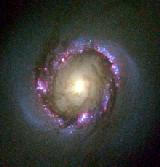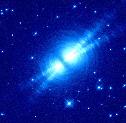 |
||
| First page | ||
 |
||
| Chandra | ||
 |
||
| Hubble Space Telescope | ||
 |
||
| Infrared Space Observatory | ||
 |
||
| Integral | ||
 |
||
| International Ultraviolet Explorer | ||
 |
Next Generation Space Telescope | |
 |
||
| XMM-Newton | ||
 |
||
| X-ray Timing Explorer | ||
 |
||
| Want to know more? | ||
 |
||
 |
||
The Hubble Space Telescope
(1990 - present)

The Hubble Space Telescope allows us to see what's going on in the universe much more clearly than a ground-based telescope would do.
HST was put into orbit by the space shuttle Discovery, in April 1990. It is one of the largest and most advanced satellites ever built and took more than 20 years research by NASA and other scientists. The telescope is named after the American astronomer Edwin P. Hubble.
HST is orbiting just 380 miles above our planet's surface and barely skims the atmosphere. It is in space because that makes it possible to see the universe more clearly than we can from Earth. Since we live at the bottom of Earth's atmosphere our vision is blurred. The atmosphere smears and scatters starlight and is the reason stars twinkle. Therfore the best view of the universe is from above the Earth's atmosphere.
HST is famous for it's stunning photos (you can see some of them on this page) that provides new clues to black holes, the birth of galaxies and planetary systems around stars.
HST in space
The 12-ton telescope looks like a five-storey tower of stacked silver canisters and is as large as a school bus. Each canister houses important telescope equipment: the focussing mirrors, computers, imaging instruments and pointing and control mechanisms. Extending from the telescope are solar panels for generating electricity and antennas for communicating with operators on the ground.
It collects faint starlight with an 8-foot-diameter mirror that is slightly curved to focus and magnify light. To take pictures of distant or faint objects, Hubble must maintain a steady position for a long time, sometimes hours, otherwise the images will be blurred. To accomplish this mission, the telescope must battle such celestial elements as air drag, the sun's radiation, and the gravitational pull of objects. The main reason Hubble is successful is its sophisticated pointing control system - once the telescope locks onto an object, its sensors check for movement 40 times a second. If movement occurs, the wheels, which are constantly rotating, change speeds to smoothly move the telescope back into position.
The Hubble Space Telescope whirls around Earth at 5 miles per second and completes an Earth orbit in 97 minutes. For half of each orbit, the telescope passes through Earth's shadow, where temperatures plunge to 250 degrees below zero. When Hubble swings back into sunlight, outside temperatures are more than 100 degrees. Hubble is protected from these temperature extremes by an exterior thermal blanket, which allows the telescope to maintain a constant temperature. The telescope receives its power from a pair of rectangular 40-foot-long solar arrays. The sun light is converted into 2,400 watts of electricity - enough to power two dozen household light bulbs.
Planning Hubble's day

Because Hubble is not always in direct communication with ground stations, operators cannot control the telescope every minute, as people do radio-controlled airplanes. Instead, every second of Hubble's activities in space must be planned in detail. The detailed instructions are converted into a code the spacecraft's main computer can understand. The telescope's pointing systems then find and lock onto distant planets, stars, and galaxies. This task requires the same precision as pointing and holding a laser on a penny 400 miles away.
To make an observation, Hubble must find a pair of bright stars called guide stars near each target planet, star, or galaxy. These bright stars are Hubble's anchors. Guide stars allow Hubble to maintain its steadiness on a target, just as anchors keep a ship from drifting. To find guide stars for nearly every object in the sky, mission planners use an immense catalogue containing the sky addresses of 15 million stars.
Astronauts paying a visit

In February 1997, NASA astronauts paid a visit to the Hubble Space Telescope. The astronauts brought new scientific instruments: a spectrograph and an infrared camera. They greatly improved Hubble's ability to see the universe.
The mission's most important objective was to install two devices to fix Hubble's vision problem. Because Hubble's primary mirror was incorrectly shaped, the telescope could not focus light to a single sharp point. Instead, it saw a fuzzy halo around objects it observed. Once Hubble received its corrective glasses, it began seeing clearly again.
HST is designed for servicing in space. The telescope's instruments were created as modular units, that can be easily removed and replaced. Designers also equipped the telescope with handholds and other special features to make servicing tasks less difficult for astronauts wearing bulky spacesuits. Astronauts will visit the telescope again in 2002 and 2005 to install new components and instruments that represent the cutting edge of technology.
HST links
Space Telescope Science Institute, Public information about HST
Hubble picture gallery, Lots of pretty pictures
2nd August 2000
Emma Button
Sarah Amandusson
www_astro@mssl.ucl.ac.uk